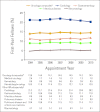Tracking the workforce: the American Society of Clinical Oncology workforce information system
- PMID: 23633965
- PMCID: PMC3545660
- DOI: 10.1200/JOP.2012.000827
Tracking the workforce: the American Society of Clinical Oncology workforce information system
Abstract
Purpose: In anticipation of oncologist workforce shortages projected as part of a 2007 study, the American Society of Clinical Oncology (ASCO) worked with a contractor to create a workforce information system (WIS) to assemble the latest available data on oncologist supply and cancer incidence and prevalence. ASCO plans to publish findings annually, reporting on new data and tracking trends over time.
Methods: THE WIS REPORT IS COMPOSED OF THREE SECTIONS: supply, new entrants, and cancer incidence and prevalence. Tabulations of the number of oncologists in the United States are derived mainly from the American Medical Association Physician Masterfile. Information on fellows and residents in the oncology workforce pipeline come from published sources such as Journal of the American Medical Association. Incidence and prevalence estimates are published by the American Cancer Society and National Cancer Institute.
Results: The WIS reports a total of 13,084 oncologists working in the United States in 2011. Oncologists are defined as those physicians who designate hematology, hematology/oncology, or medical oncology as their specialty. The WIS compares the characteristics of these oncologists with those of all physicians and tracks emerging trends in the physician training pipeline.
Conclusion: Observing characteristics of the oncologist workforce over time allows ASCO to identify, prioritize, and evaluate its workforce initiatives. Accessible figures and reports generated by the WIS can be used by ASCO and others in the oncology community to advocate for needed health care system and policy changes to help offset future workforce shortages.
Figures


References
-
- American Board of Internal Medicine. ABIM exam information and statistics. http://www.abim.org/about/exam-information-statistics.aspx.
-
- Key Trends in Tracking Supply of and Demand for Oncologists. Washington, DC: Association of American Medical Colleges; 2012. A Report to the American Society of Clinical Oncology (ASCO) from the AAMC Center for Workforce Studies.
-
- American Medical Association. Online data collection center. http://www.ama-assn.org/ama/pub/about-ama/physician-data-resources/onlin....
MeSH terms
LinkOut - more resources
Full Text Sources
Other Literature Sources
Research Materials

